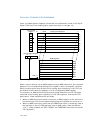
Vol. 3 12-1
CHAPTER 12
INTEL
®
MMX
™
TECHNOLOGY SYSTEM
PROGRAMMING
This chapter describes those features of the Intel
®
MMX™ technology that must be
considered when designing or enhancing an operating system to support MMX tech
-
nology. It covers MMX instruction set emulation, the MMX state, aliasing of MMX
registers, saving MMX state, task and context switching considerations, exception
handling, and debugging.
12.1 EMULATION OF THE MMX INSTRUCTION SET
The IA-32 or Intel 64 architecture does not support emulation of the MMX instruc-
tions, as it does for x87 FPU instructions. The EM flag in control register CR0
(provided to invoke emulation of x87 FPU instructions) cannot be used for MMX
instruction emulation. If an MMX instruction is executed when the EM flag is set, an
invalid opcode exception (UD#) is generated.
Table 12-1 shows the interaction of the
EM, MP, and TS flags in control register CR0 when executing MMX instructions.
12.2 THE MMX STATE AND MMX REGISTER ALIASING
The MMX state consists of eight 64-bit registers (MM0 through MM7). These registers
are aliased to the low 64-bits (bits 0 through 63) of floating-point registers R0
through R7 (see
Figure 12-1). Note that the MMX registers are mapped to the phys-
ical locations of the floating-point registers (R0 through R7), not to the relative loca-
tions of the registers in the floating-point register stack (ST0 through ST7). As a
Table 12-1. Action Taken By MMX Instructions
for Different Combinations of EM, MP and TS
CR0 Flags
EM MP* TS Action
0 1 0 Execute.
0 1 1 #NM exception.
1 1 0 #UD exception.
1 1 1 #UD exception.
NOTE:
* For processors that support the MMX instructions, the MP flag should be set.


















